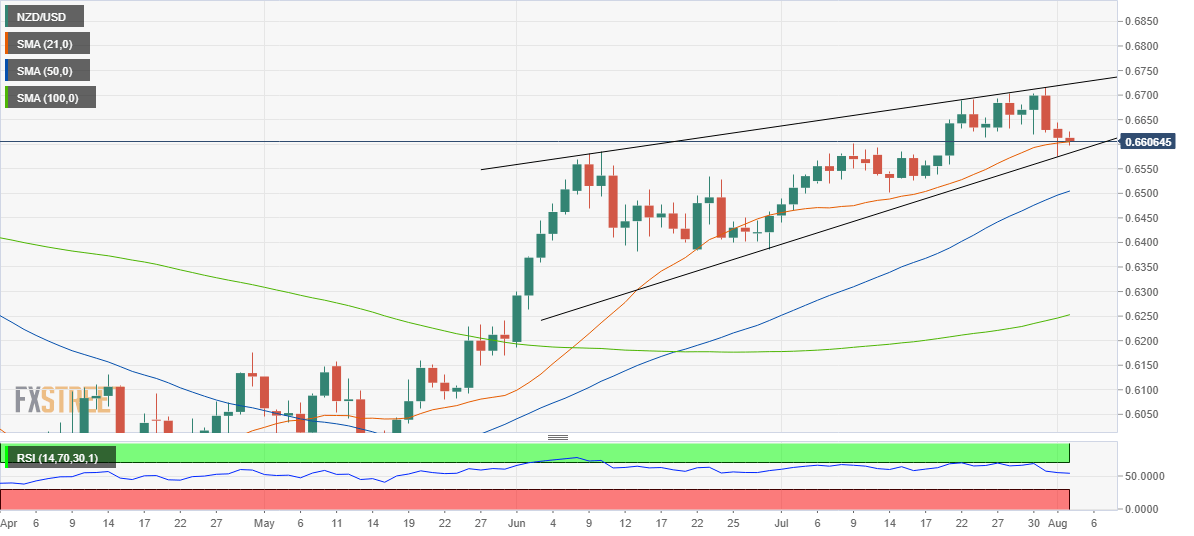- New Zealand Q2 jobs data to show a big jump in unemployment.
- Kiwi risks further falls on a poor employment show.
- Dollar weakness could likely cushion NZD/USD’s downside.
Despite having managed the coronavirus crisis relatively well, the economic costs of the virus resurgence and the subsequent impact on New Zealand’s (NZ) labor market cannot be written-off.
The second-quarter employment report is set to show an aggressive jump in the unemployment this Wednesday at 2245 GMT. With the Reserve Bank of New Zealand (RBNZ) adapting its monetary policy settings to “maintain price stability and support maximum sustainable employment”, a worse-than-expected report could prompt the central bank to expand its quantitative easing (QE) programme or steer the key rates into the negative territory.
The unemployment rate is expected to have leapt to 5.8% in the three months to June after rising to 4.2% in Q1. Employment in the country is likely to have fallen by 2.0% when compared to a 0.7% rise seen in the previous quarter. The participation rate is seen ticking lower to 69.8% vs. the previous 70.4%. The labor cost index is expected to have increased by 0.3% QoQ and by 1.9% YoY.
The sluggish employment data could boost the dovish RBNZ expectations and exacerbate the pain in the kiwi. Although the reaction to the outcome is likely to be short-lived, as the risk-sensitive NZD will continue to remain at the mercy of the market mood and US dollar dynamics.
Recall that the RBNZ left the Cash Rate unchanged at a record low of 0.25% for the second straight month in June while maintaining its QE programme size at around NZD60 billion.
NZD/USD Technical outlook
NZD/USD is on a decent over the last couple of trading sessions, following a failure to resist above the 0.6700 level. Despite the weakness, the price keeps its range within a rising wedge formation on the daily chart, which has a natural tendency of a breakdown.
Should the data disappoint the market forecasts, the Kiwi could likely see a technical break of the rising trendline support at 0.6582. Although a daily close below the latter is critical to validate the pattern. The bullish 50-day Simple Moving Average (DMA) at 0.6505 could rescue the bulls if the selling pressure intensifies.
On the flip side, daily closing above the 21-DMA at 0.6605 could call for a bounce towards Monday’s high of 0.6644 en route the 0.6700 round figure. The daily Relative Strength Index (RSI) points south but holds above the midline, suggesting limited scope for the downside.
NZD/USD Daily chart

Information on these pages contains forward-looking statements that involve risks and uncertainties. Markets and instruments profiled on this page are for informational purposes only and should not in any way come across as a recommendation to buy or sell in these assets. You should do your own thorough research before making any investment decisions. FXStreet does not in any way guarantee that this information is free from mistakes, errors, or material misstatements. It also does not guarantee that this information is of a timely nature. Investing in Open Markets involves a great deal of risk, including the loss of all or a portion of your investment, as well as emotional distress. All risks, losses and costs associated with investing, including total loss of principal, are your responsibility. The views and opinions expressed in this article are those of the authors and do not necessarily reflect the official policy or position of FXStreet nor its advertisers. The author will not be held responsible for information that is found at the end of links posted on this page.
If not otherwise explicitly mentioned in the body of the article, at the time of writing, the author has no position in any stock mentioned in this article and no business relationship with any company mentioned. The author has not received compensation for writing this article, other than from FXStreet.
FXStreet and the author do not provide personalized recommendations. The author makes no representations as to the accuracy, completeness, or suitability of this information. FXStreet and the author will not be liable for any errors, omissions or any losses, injuries or damages arising from this information and its display or use. Errors and omissions excepted.
The author and FXStreet are not registered investment advisors and nothing in this article is intended to be investment advice.
Recommended Content
Editors’ Picks
AUD/USD could extend the recovery to 0.6500 and above

The enhanced risk appetite and the weakening of the Greenback enabled AUD/USD to build on the promising start to the week and trade closer to the key barrier at 0.6500 the figure ahead of key inflation figures in Australia.
EUR/USD now refocuses on the 200-day SMA

EUR/USD extended its positive momentum and rose above the 1.0700 yardstick, driven by the intense PMI-led retracement in the US Dollar as well as a prevailing risk-friendly environment in the FX universe.
Gold struggles around $2,325 despite broad US Dollar’s weakness

Gold reversed its direction and rose to the $2,320 area, erasing a large portion of its daily losses in the process. The benchmark 10-year US Treasury bond yield stays in the red below 4.6% following the weak US PMI data and supports XAU/USD.
Bitcoin price makes run for previous cycle highs as Morgan Stanley pushes BTC ETF exposure

Bitcoin (BTC) price strength continues to grow, three days after the fourth halving. Optimism continues to abound in the market as Bitcoiners envision a reclamation of previous cycle highs.
US versus the Eurozone: Inflation divergence causes monetary desynchronization

Historically there is a very close correlation between changes in US Treasury yields and German Bund yields. This is relevant at the current juncture, considering that the recent hawkish twist in the tone of the Federal Reserve might continue to push US long-term interest rates higher and put upward pressure on bond yields in the Eurozone.